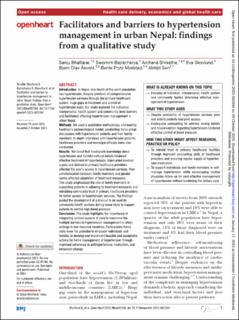| dc.contributor.author | Bhattarai, Sanju | |
| dc.contributor.author | Bajracharya, Swornim | |
| dc.contributor.author | Shrestha, Archana | |
| dc.contributor.author | Skovlund, Eva | |
| dc.contributor.author | Åsvold, Bjørn Olav | |
| dc.contributor.author | Mjølstad, Bente Prytz | |
| dc.contributor.author | Sen, Abhijit | |
| dc.date.accessioned | 2024-02-13T11:58:45Z | |
| dc.date.available | 2024-02-13T11:58:45Z | |
| dc.date.created | 2023-12-18T12:17:39Z | |
| dc.date.issued | 2023 | |
| dc.identifier.issn | 2053-3624 | |
| dc.identifier.uri | https://hdl.handle.net/11250/3117266 | |
| dc.description.abstract | Introduction In Nepal, one-fourth of the adult population has hypertension. Despite provision of comprehensive hypertension services through the primary healthcare system, huge gaps in treatment and control of hypertension exist. Our study explored the individual, interpersonal, health system and community-level barriers and facilitators affecting hypertension management in urban Nepal.
Methods We used a qualitative methodology informed by Kaufman’s socioecological model, conducting focus group discussions with hypertension patients and their family members. In-depth interviews with hypertension patients, healthcare providers and municipal officials were also conducted.
Results We found that inadequate knowledge about hypertension and harmful cultural beliefs hindered effective treatment of hypertension. Interrupted medical supply and distrust in primary healthcare providers affected the poor’s access to hypertension services. Poor communication between family members and gender norms affected adaptation of treatment measures. This study emphasised the role of family members in supporting patients in adhering to treatment measures and rebuilding community trust in primary healthcare providers for better access to hypertension services. The findings guided the development of a manual to be used by community health workers during home visits to support patients to control high blood pressure.
Conclusion The study highlights the importance of integrating various aspects of care to overcome the multiple barriers to hypertension management in urban settings in low-resource countries. Participatory home visits have the potential to empower individuals and families to develop and implement feasible and acceptable actions for home management of hypertension through improved adherence to antihypertensive medication, and behaviour change. | en_US |
| dc.language.iso | eng | en_US |
| dc.publisher | BMJ Publishing Group Ltd. | en_US |
| dc.rights | Navngivelse-Ikkekommersiell 4.0 Internasjonal | * |
| dc.rights.uri | http://creativecommons.org/licenses/by-nc/4.0/deed.no | * |
| dc.title | Facilitators and barriers to hypertension management in urban Nepal: Findings from a qualitative study | en_US |
| dc.title.alternative | Facilitators and barriers to hypertension management in urban Nepal: Findings from a qualitative study | en_US |
| dc.type | Peer reviewed | en_US |
| dc.type | Journal article | en_US |
| dc.description.version | publishedVersion | en_US |
| dc.source.volume | 10 | en_US |
| dc.source.journal | Open heart | en_US |
| dc.source.issue | 2 | en_US |
| dc.identifier.doi | 10.1136/openhrt-2023-002394 | |
| dc.identifier.cristin | 2214811 | |
| cristin.ispublished | true | |
| cristin.fulltext | original | |
| cristin.qualitycode | 1 | |

